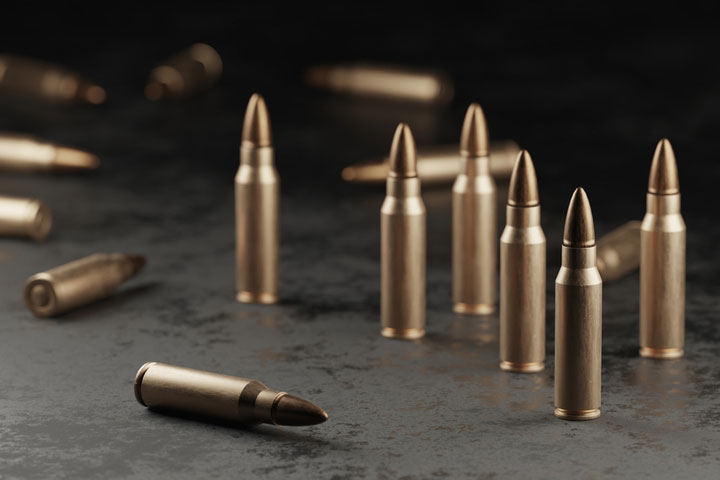Examine This Report on Ammunition Pro Llc
Examine This Report on Ammunition Pro Llc
Blog Article
Ammunition Pro Llc Fundamentals Explained
Table of Contents7 Simple Techniques For Ammunition Pro LlcAmmunition Pro Llc Can Be Fun For EveryoneSome Of Ammunition Pro LlcGetting My Ammunition Pro Llc To WorkThe Ammunition Pro Llc Diaries
A lot of contemporary cartridges contain four main components the situation, guide, propellant, and projectile. A shotgun cartridge, even more typically referred to as a shell, consists of 5 elements the situation, primer, propellant, projectile(s) and wad. Allow's look at each part of a round, exactly how it functions, and alternatives that may be readily available: The covering is the container, or real estate, into which all the various other parts fit.Technically, the increased use steels apart from brass have made this jargon incorrect, however, it continues to be a typically made use of and approved term. If you will be refilling you need to stick to brass, brass alloy or plated brass. Pure initial run brass is best; nevertheless, recycled brass can be used. Buy Ammo Online.
Other types of brass, consisting of alloys or layered versions, can be utilized however will certainly have a much shorter lifetime. Early firearms depended on gunpowder, which is a specific combination of chemicals that sheds rapidly and promptly develops broadening gases as it melts. Creating the ability to confine and control the burning process and gas development was the essential to creating trustworthy, and secure, firearms.
Due to its instability gunpowder has actually been changed by modern-day chemical substances that complete the same result without the threat. The most common of these combinations is saltpeter, sulfur, and charcoal. The result is a propellant that sheds fast, is reputable and more secure. The propellant needs a smaller sized charge to be safely igniting and this is achieved by the guide.
10 Easy Facts About Ammunition Pro Llc Shown
As holds true with the propellant, gunpowder has been replaced by more steady contemporary chemical compounds in the construction of the guide. Quality guides are necessary to proper, reputable ammunition efficiency. A damaged or wet guide will typically cause failing to fire or a delayed, hang, fire situation.
the bulletEvery firearm calls for an item that will certainly be expelled from the weapon which will, consequently, be used to hit the desired target. This item is called the projectile, although the terms bullet, slug or shot are frequently used in its location. Actually rifles & pistols fire bullets while shotguns fire slugs or shot, the last being utilized to describe a group of pellets eliminated from a single covering or covering.
Some manufacturers have actually even try out including a polymer cone to hollow point styles. The result is managed expansion and much deeper penetration. Bullets, which is an acceptable term for the projectile for many modern guns, can be found in a variety of types. Each is developed for a various objective and might or might not cycle correctly in every gun.
The 4-Minute Rule for Ammunition Pro Llc
As reviewed previously, the case is the housing into which the other components are housed. When it comes to centerfire cartridges (the most typical type of modern ammunition) the primer is suited a pocket in the base of the instance, the propellant is loaded right into the hollow interior space and a projectile (aka bullet) is secured right into the open end.
The shooting pin, subsequently, relocated quickly ahead and strikes the guide. When struck by the shooting pin the guide ignites and almost instantly fires up the propellant by allowing a fire to get in the cartridge by means of a little hole behind the primer cap. This causes a rapid chain reaction that produces expanding gases which, as a result of the confined space within the instance, trigger the projectile to be quickly expelled.
Certainly, every weapon proprietor has a duty to review the proprietor's handbook and practice secure capturing. Before you understand it, you will be the one others concern for information, waiting patiently while you fire so they can ask "Is it a bullet, ammunition, or cartridge?".
Not known Facts About Ammunition Pro Llc

All are instances of self-contained ammunition, which has actually been with us for more than a century. Using these four components, ammo is either made by factories or handloaders, and though the make-up and design of the standard components have advanced and remain to do so, their overall function and just how they collaborate have not.
Cartridge situations are normally made of brass. They will certainly hold the guide, gunpowder, and projectile. (Photo/Richard Mann)The cartridge situation is what holds all self-contained ammo with each other. With rifle and hand gun ammunition, the case is in some cases described as "brass." With shotguns, the situation is frequently called a covering or a hull.
The 2-Minute Rule for Ammunition Pro Llc
Brass cases are reloadable, while steel situations are not. With shotgun hulls or coverings, the base is made of brass for strength, and the rest of the instance is made of plastic for economy.
With the majority of shotgun shells, added details about the tons is printed on the plastic part of the hull. Shooting Supplies. Centerfire guides match the cartridge or shell head, and when affected by the shooting pin they develop a trigger to begin the gunpowder melt. (Photo/Richard Mann)There are two kinds of priming techniques made use of in modern-day, self-contained ammunition
Report this page